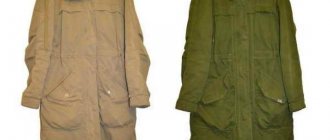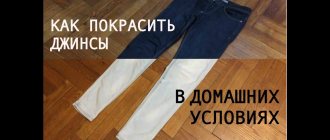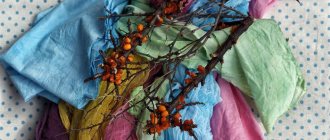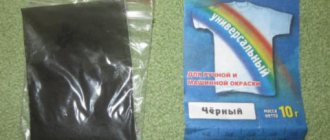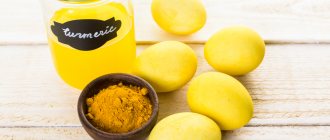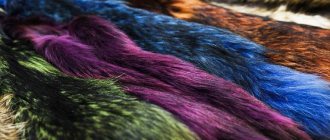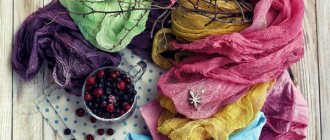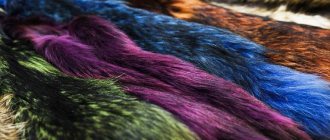Repeated washing in a washing machine, especially with the use of bleaching additives, as well as bright sunlight reduces the color fastness of the fabric. Fabrics made from cotton fibers are especially susceptible to this. Paints fade or fade and fade, losing their former brightness.
The best solution to refresh the appearance of such fabric is to dry-clean such clothes. Dry cleaning uses special durable dyes and uses reliable technology, which guarantees almost factory-quality dyeing of fabrics. However, you can dye old jeans or skeins of yarn at home using special aniline universal dyes intended for household use.
Preparing for painting
Before you start working, you need to stock up on dyes and choose a method for doing the work.
Suitable materials
You can paint any item of clothing yourself using special paints .
There is a wide variety of colors available on the modern market. With such a spectrum, everyone can choose the shade they need.
Coloring methods
Fans of experiments identify several methods suitable for painting a product .
- The most popular is dyeing in a washing machine . However, paint may remain on the drum walls. This will lead to damage to other wardrobe items.
- Instead of a washing machine, you can use the manual method. For this purpose, enamel dishes are suitable, which are placed on low heat. The main thing when painting is to follow the manufacturer's recommendations .
How to paint it black
In the washing machine
In order to dye faded trousers black, you need to select the appropriate dyes. When the material has been selected, we begin the technological process.
For painting in a washing machine, it is recommended to use powder dyes .
- Pour the powder into a bowl and pour in about two glasses of hot water (per package) .
- Mix thoroughly to completely dissolve the paint.
- When the dye has dissolved, add a tablespoon of salt and mix again .
Note: It is recommended to use coarse salt.
- Now pour water into a large basin and add dye there .
- You also need to add one tablespoon each of vinegar and washing powder .
- Mix the resulting solution and pour it into the machine, then put the trousers in and wash with boiling water.
- After finishing, it is recommended to rinse the product additionally .
Important: the trousers must be damp before dyeing.
Painting by hand
To paint by hand, you need to purchase the appropriate paint.
- The paint is diluted with hot water and mixed until completely dissolved.
- After mixing, pour the paint into a large container (for example, a pan) and place the trousers.
- The pan is placed on low heat for about 40 minutes .
- During the cooking process, it is necessary to periodically stir the trousers . A special metal clamp or large spoon is suitable for this.
- While the trousers are going through the cooking process, you can prepare a rinse solution . Add 1 tablespoon each of vinegar and salt .
- When the dyeing time has expired, the trousers must be rinsed several times in a container with a solution, and then with regular running water.
The product is ready. Black trousers in front of you.
Help: salt and vinegar are used to accurately fix the color.
A few simple steps will help restore the brightness and saturation of the product.
Dyeing fabrics with natural dyes: step-by-step instructions
How to dye fabric if you only have the contents of the refrigerator and groceries?
The following step-by-step instructions will help you avoid mistakes:
- Grind the coloring ingredient with a knife or grater, if necessary.
- Place in a saucepan and add water in a ratio of 1 to 2.
- Bring to a boil and leave for an hour. For a more saturated pigment, you can leave the liquid overnight.
- Strain the water thoroughly: make sure that there are no small pieces left in it - otherwise they will leave stains on your clothes.
- Prepare a paint fixative: if you are using berry or fruit juice, add half a cup of salt to 2 liters of water, bring to a boil, put a cloth there and boil for an hour. The proportions can be increased according to the size of the item being painted. If you paint with vegetables, spices or herbs, you need a vinegar solution. To prepare it, add four equal portions of water to one part of vinegar, put a cloth there and heat over low heat for an hour.
- After the time has passed, remove the item from the fixative solution and rinse in ice water.
- Dip the fabric into the dye and leave it for a while - the longer it stays there, the richer its final color will be.
When the product dries, the fabric will turn pale. Take this into account and paint the product longer if necessary.
Adding blue shades
There are also several methods for dyeing pants blue.
First of all, the use of ordinary blue - a mixture of methylene blue with starch. It is suitable for refreshing the product and giving it a more saturated color.
Manual method
- The dye is diluted in the amount of warm water indicated on the package, add a couple of tablespoons of table salt .
- Pants are placed in the resulting mixture. It is recommended to leave the product for several hours to obtain a bright and rich shade.
- Turn over about once every 2 hours to ensure even coloring.
- Before completing the process, you can prepare a solution with vinegar. Add 2 tablespoons of vinegar per liter of water . It is necessary to soak the painted product in the resulting solution for several minutes to consolidate the result. Then rinse several times.
Machine method
- When painting in a machine, powder dye is more suitable . It is diluted with boiling water and poured directly into the drum .
- Next come the trousers . It is recommended to set the mode to “Boiling”.
- While the product is going through the stages of dyeing, prepare a solution with vinegar . must be kept in it for at least 15 minutes.
- Afterwards rinse with water .
These steps will help restore your trousers’ rich color and well-groomed appearance.
Useful tips
For competent and complete coloring, you must follow several recommendations.
- For high-quality dyeing, it is recommended to use a dye suitable for the given fabric .
- When painting in a washing machine, the mixture must be poured into the drum, and not into the window for washing powder .
- To get a darker blue hue, you can add a little black paint..
- A solution of vinegar and salt is required when rinsing . It helps consolidate the result and prolong its quality.
- Before dyeing, trousers must be washed and all stains removed . When stained, they will reappear on the product.
FAQ on dyeing non-standard fabrics
How to dye faded fabric if the above methods are not suitable? Below we will talk about how to dye fabric if you are faced with a non-standard task.
- How to paint a tarpaulin ? This fabric can be repainted with construction colors or rubber paint. In both the first and second cases, the coating will take a long time to dry.
- How to hide a stain on clothes? If the problem is a stain, try ironing the item from the inside out through a clean cloth. There is a possibility that it will work. If this method does not help, use a fabric marker and cover the stain with an acrylic design or transfer applique.
- How to cover burlap? – This fabric can be painted using a spray or water-based paint, applying it with a brush using percussive movements. Do not paint over the burlap completely, otherwise it will become too tough.
- How to paint a raincoat fabric? — Nylon dye is suitable for raincoat fabric.
- How to dye rubberized fabric ? – To color rubberized fabric, mix rubber glue and construction color in equal proportions. Apply the resulting composition to the product with a brush and leave until completely dry.
- How to repaint synthetic winterizer? – The desired color of padding polyester can be easily achieved by using auto enamel spray.
How to choose paint
- Compound. Before purchasing, you need to pay attention to whether the ingredients of the product are listed on the label. In the production of counterfeit paints and compositions that are produced in artisanal conditions, important information is often missing, including the types of main components. In addition, the composition allows you to determine how high-quality and effective the chosen product is. Thus, it is recommended to purchase a helmet that does not contain lavsan and niton. These components can ruin the item because they contribute to its uneven coloring.
- Material type. The label indicates for which fabrics the composition is intended. If the wrong product is used, the material may be colored unevenly or may result in a color that is not what was expected, such as a lighter color. There is another danger: the material will be colored, but after the first wash it will begin to fade a lot.
- Type of paint. The compositions differ in structure, which determines their properties. The choice is made taking into account the method of application of the pigment. This is due to the fact that each type of paint is designed to paint products under given conditions. When the requirements for the procedure are not met, the quality of the painting deteriorates.
- Application of universal compositions. In the absence of information about the type of material, it is permissible to use a product that is suitable for dyeing cotton, linen, wool, silk, and viscose fabrics. In this case, the color can be preserved for a shorter period than in the case when a highly specialized composition is selected.
- Best before date. It is not recommended to use products that have lost their properties.
What fabrics can be dyed
Natural fabrics are easier to dye than synthetics. Cotton, linen, silk, and wool absorb pigments well, but artificial fabrics cannot be dyed evenly.
Items with sequins, beads, inserts or embroidery may look sloppy after dyeing. Therefore, before the procedure, all accessories are stripped from clothing, since metal, plastic and wood react to dyes.
Light fabrics can be given any shade, dark fabrics can only be given more intensity. If you are going to repaint a black item, you first need to bleach it and only then paint it.
If things often shed during washing, you may not be caring for them correctly. To keep your favorite clothes looking longer, take them to the dry cleaner: specialists will select effective cleaners that will not spoil the color of the fabric.
Preparing for coloring
Considering that the process of updating trousers is accompanied by the appearance of paint splashes, you should choose a safe place in the apartment. It is better to perform similar actions in the bathroom, here you can clean the walls if necessary, since they are covered with moisture-resistant material from which dirt can be easily removed.
However, there is a risk of staining textiles: curtains, linen that is drying, etc. Such things must be removed from the room.
To avoid having to do general cleaning after finishing the procedure, you can additionally protect the surfaces with newspapers and polyethylene.
It is important to check the item for grease stains and traces of other complex contaminants. This can cause a deterioration in the quality of painting, since in these areas the pigment penetrates less intensively into the structure of the material coated with impermeable compounds (grease, paint, etc.). If possible, remove stains.
To ensure that the product looks like new after all manipulations, it is recommended to rip off the tags, stripes on the front side of the trousers, and also remove the emblems. If this is not done, all decorative elements will change color to a darker one.
You can pre-lighten the product. Then when dyeing it will be possible to get a more saturated color.
The following substances are used for this:
- oxygen or chlorine based bleaches;
- laundry soap;
- hydrogen peroxide;
- ammonia.
Dyeing clothes
To dye fabric, choose one of the techniques:
- Airbrush - painting using a spray can or airbrush.
- Shibori, tie-dye, plangi - knot painting. Before immersing the fabric in paint, it is pulled with threads, twisted, tied into knots and the folds are fixed with clothespins.
- Hot and cold batik. Patterns are created with hot wax or a special compound and the item is filled with dye. The areas where there was wax are the drawing, the painted areas are the background.
- Free painting.
- Boiling or soaking.
Preparation
Even new clothes need to be washed and ironed before painting. This will smooth out the fibers and allow the color to lie evenly. An exception is the tie-dye technique, in which the item, on the contrary, is crushed and twisted. The fittings and lining cannot be dyed together with the fabric. Pockets must be empty. When using any paint, read the instructions carefully so as not to damage the fabric.
Inventory
For partial staining you will need:
- brushes;
- cotton buds;
- a temporary pencil or self-disappearing sketch marker;
- stencil or copy paper;
- paper tape for a clear outline or fixation of the stencil;
- sponge if you need to shade the paint;
- wax, paraffin for batik;
- a hoop or sheet of thick cardboard to stretch the fabric;
- iron.
For full coloring:
- basin or pan;
- gauze or colander for straining broths;
- gloves, tweezers or wooden sticks for turning the fabric.
General recommendations
There are certain recommendations for coloring:
- Paint each item separately.
- When you soak, periodically remove and dip again to properly paint the texture.
- The dye penetrates deeper into the fibers of the fabric in hot water, but after dyeing it is not recommended to wash things at high temperatures.
- In decoctions of leaves and berries, the fabric can be boiled for about 40 minutes.
- The seams are not painted over.
- Faded fabric easily absorbs dye.
- Stains interfere with dyeing - contaminated areas will differ in color.
- Natural dyes take longer to dye the fabric, and the color is unstable.
- After painting, the item should be rinsed well until the water becomes clear.
- When drying, woolen items are carefully laid out, otherwise they will stretch.
- Do not leave things in the sun for a long time so that the color does not fade again.
- Wash dyed items separately from the rest for a while.
Types of dyes
Industrial production means:
- powder compositions: paint is available in dry form, in powder form;
- Ready-to-use liquid products are specially developed pigments intended for dyeing fabrics.
Use available tools:
- refilling printer cartridges (black);
- natural coffe;
- tobacco ash.
These options are not recommended for improving the color of expensive items, since there is a high probability that the trousers will be irreparably damaged. There is no guarantee of a good result in this case.
How to paint it black
At the selection stage, the appropriate type of pigment is determined. First put on rubber gloves. If this is not done, the skin on your hands will darken.
In the washing machine
In this case, powder dye is used. It must be properly prepared. So, use a glass container; a metal spoon is needed to mix the solution. Powder paint is mixed with hot water in the ratio of 1 package of powder to 2 cups of liquid. When the mixture has become uniform, add 1 tbsp. l. salt. The composition must be mixed again until a homogeneous substance is obtained.
The finished dye is mixed with water. The amount of liquid is determined by the manufacturer; such information can be found on the label. Add 1 tbsp to the prepared solution. l. vinegar and the same amount of washing powder. At the last stage, the dye is poured into the machine. The trousers are placed in a drum. High temperature mode (+90°C) is recommended. At the end of the cycle, the product is rinsed.
Painting by hand
The pigment is combined with water, and the liquid must be hot. The paint is poured into the container. It is more convenient to mix the components in a basin: immerse the trousers in the prepared solution and place the container on the stove. The fire should be low and should not be brought to a strong boil. Warm-up duration is 40 minutes. The product that is being painted must be stirred periodically, for which a metal object, such as a spoon, is used.
Prepare the rinse liquid: fill a basin with water, add 1 tbsp. l. vinegar and the same amount of salt. The solution helps set the color. When the heating period for the product is over, the trousers need to be rinsed several times in the prepared product, and then in running water.
Dyeing jeans blue
For this purpose, a classic version of the dye used in domestic conditions is often used - blue. You can also take industrial products for highly specialized purposes - for dyeing fabric blue.
Machine method
The technology in this case is the same as when using black pigment. However, it is recommended to rinse the product in a solution of water and vinegar.
First, jeans are soaked in this product for 15 minutes, after which they proceed to rinsing in running water. The manipulations are repeated until the pigment stops flowing from the fabric.
Manual method
Dilute the dye with water in accordance with the manufacturer's recommendations. Add 2 tbsp to the resulting solution. l. salt. In order for the dye to do its job better, it is recommended to soak your trousers in it for several hours. The color will be uniform if you turn the product over every 2 hours.
For rinsing, prepare another solution: 1 liter of water and 2 tbsp. l. vinegar, the amount of components changes proportionally. It is necessary to soak the jeans in this product for 15 minutes, after which the product is rinsed in running water.
They do a lot of things to jeans to give them a fashionable look - tinder, boil them, tear them, decorate them with rhinestones and appliqués. “Distressed” denim has been popular for a long time. But lovers of conservative plain trousers, on the contrary, prefer to dye their jeans if they have begun to fray and lose their color uniformity.
If you decide to dye your jeans, you don’t have to take them to the dry cleaner - you can restore the color of the fabric yourself at home. Both special dyes and a variety of improvised means are suitable for coloring.
It is easier to achieve high-quality uniform dyeing of fabric when the selected paint matches the original color or is darker than it. That is, any jeans can be easily dyed black, but turning black trousers, for example, into blue is unlikely.
Not all fabrics can be dyed at home
Dyeing simple cotton clothes gives you the opportunity to add a new touch of color to your wardrobe without breaking the bank. Dying children's clothing dark colors can save items that have been badly stained and destined to be thrown away. However, not all types of fabrics can be dyed at home. A number of fabrics with a high content of synthetic fibers cannot be dyed at home with aniline dyes. Even if the color of such fabrics changes, after the first wash the dye will be washed off and their shade will become an indefinite color.
To dye fabric made from synthetic fibers, special dyes and special technology (temperature conditions, etc.) are used. At home, you can “confidently” dye only cotton and woolen fabrics, since the fibers of such fabrics absorb paint well and do not fade much after washing.
If you decide to get a set of fashionably colored T-shirts, buy a package of inexpensive white T-shirts and a set of universal dyes in a variety of colors. White is ideal for conveying the shade and color you want. Any other color of the fabric will make certain adjustments to the final dyeing result. Be prepared for the fact that colored clothing cannot be dyed to the perfectly “pure” color indicated on the dye package.
How to dye blue jeans
Let's move straight to the description of the means with which you can restore the rich blue color of your jeans.
Traditional denim dye used to be made from the Indian indigo plant, from which it gets its name. Its color is characterized as intermediate between dark blue and violet. To dye jeans at home and provide them with an even and lasting blue color, use ready-made textile paints and available products.
Blue
Blue in the form of a solution or powder is one of the most affordable and easy-to-use dyes.
Dyeing jeans blue is quite simple - you don't even have to boil them. It is enough to make a saturated concentrated solution using cool water (about 30 ℃) with the addition of 1-2 tbsp. l. salt for color fastness, and immerse things in it. It is recommended to soak jeans for 1.5-2 hours or even the whole night, and it is important to ensure that the fabric is completely immersed in water. After soaking, the jeans are placed in a cold vinegar solution for 10-15 minutes.
Drying painted items is necessary in a straightened form; it is best to lay them out on a horizontal surface. Otherwise, water flowing down the folds will wash away the color, making it uneven.
A serious disadvantage of blue dyeing is that the color fades quite quickly with subsequent washes, and the procedure will need to be repeated regularly.
Dylon
Dylon is one of the new household chemicals designed for both washing and tinting denim. The product is convenient, economical and quickly gaining popularity among fans of classic denim.
Aniline dyes for fabric
The use of aniline dyes for blue jeans has some peculiarities.
When using aniline dyes, table salt must be added for color fastness. Details of the technology and the required proportions must be indicated by the manufacturer on the packaging. Typically, a bag of powder paint is designed for 7-10 liters of water. It is first diluted in a small volume, achieving complete dissolution, and then poured into the full volume of water. Add salt (100 g) there and mix thoroughly. Things to be dyed are immersed in a container in a straightened form and make sure that they are completely covered with the solution.
Ready-made paints in liquid forms wash out faster and are more suitable for refreshing the base tone. To properly dye jeans or completely change their original color, it is advisable to choose paints in the form of powder formulations.
Don't be afraid to experiment and give new life to your favorite things!
Fabric dyes
Fabric dyes come in powder or liquid form. Both of these types of dyes can be purchased at hardware stores.
Each package of dye comes with detailed instructions. Be sure to read it carefully before you start dyeing your fabric. The instructions indicate in what proportions to dilute the paint to water, what is the maximum weight of clothing or fabric, the number of skeins of wool that can be dyed in one bag, etc.
For example, consider two types of Russian-made dyes. Aniline dye for fabric “Lukar” is intended for home dyeing of wool and nylon fabrics, except for lavsan and nitron. This dye can even be used to dye natural leather and fur. The paint packaging indicates the type of fabric and material that can be dyed, as well as the color and instructions.
Fabric dye “Universal” produced by Tekhnokhim (St. Petersburg) is suitable for dyeing fabrics made of cotton, linen, and viscose. To dye wool or silk fabrics, you need to buy a dye, the packaging of which will indicate “Dye for wool or silk.” There are many dye manufacturers, including foreign ones, producing paints for dyeing various clothes, fabrics, yarn, etc.
For example, you can buy a dye designed specifically for changing the color of denim or jeans. By the way, if your jeans not only require a color refresh, but also repair, then read the article “How to sew up a hole in jeans.” It discusses ways to restore torn and worn areas of jeans.
